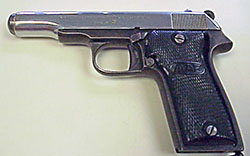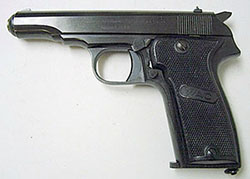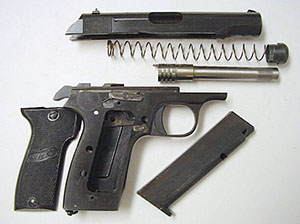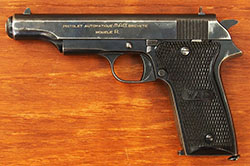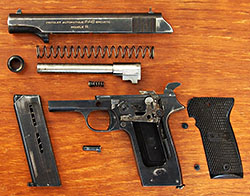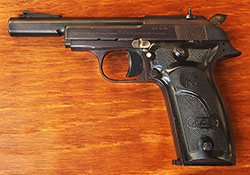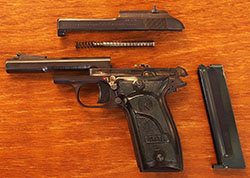 |
|||||||||||||||||||||||||||||||||||||||||||||||||||||||||||||||||||||||||||||||||||||||||||||||||||||||||||||||||||||||||||||||||||||||||||||||||||||||||||||||||||||||||||||||||||||||||||||||||
|
The M.A.B. Model R by Ed Buffaloe After World War II the Manufacture d’Armes de Bayonne was faced with rebuilding its business. The factory had been taken over by the Germans in late June 1940, and Bayonne was not liberated until 24 August 1944. The company was able to restart production of most of its models in 1946, under the leadership of Jean Barthe (pronounced “Bart”), the son of the founder, Léon Barthe. Over the next several years under Jean Barthe’s direction, production of most models was simplified wherever possible in order to reduce manufacturing time and cost. In 1949 the Model B was dropped completely. The MAB model R was a new departure for the company. According to Bastié and Casanova, who have done more research than anyone else on MAB pistols, it was intended as a replacement for the Model D, the 7.65mm version being identical in size to the Model D. Like the Model D, the Model R in calibers larger than .22 utilizes a concentric recoil spring and an unlocked breech mechanism. The Models D and R differ in that the Model R has an external hammer, no grip safety, and a mechanism to lock the slide open after the last round is fired. Additionally, when a fresh magazine is inserted into the Model R the slide automatically closes, chambering the first round. The external hammer has a half-cock position, which serves as an additional safety feature. The manual safety locks the connector bar, but does not directly block the sear. In the four years between 1950 and 1954, four different Model R pistols appeared. These are:
All these different designs were referred to by the MAB company as the Model R. I have given them individual designations for convenience in order to write about them with greater clarity. I should point out that Huon does not list the 9mm Browning Short (.380) version of the Model R, but it is listed by both Josserand and by Bastié and Casanova, and in the manual provided by MAB. However, I have been unable to locate a photograph of a Model R in 9mm Browning Short.
The Model R in 7.65mm French Long (R-32L)
According to Huon, the first Model R-32L was manufactured on 23 July 1950. He believes that almost all of these guns were shipped to Indochina, and that less than 1000 were made because he has never seen one with a serial number larger than three digits. At this time we have no other evidence as to how many were actually made. The serial number tested by Huon was 702. These guns were not exported to the U.S. and are almost never seen here. The Model R-32L is slightly longer than the Model D, due to its extended grip tang and the slightly deeper grip necessary to accommodate the longer cartridge. It has an external hammer with a round head with a hole drilled through it. Like the Model D, the magazine release and manual safety lever are both on the left side where they are easily accessible to the thumb of a right -handed shooter. There is an external slide release inconveniently located on the right side of the gun. The lever pivots just behind the pivot point of the trigger, and extends backward under the top portion of the right grip plate, which is split to allow the checkered button to be pressed downward. However, a slide release is only occasionally necessary since the gun automatically frees the slide when a new magazine is inserted. There is a lanyard ring on the bottom of the grip. Like the Model D and the 1910 FN Browning, the barrel is retained by three transverse lugs just beneath the chamber which fit into grooves in the top of the frame. There is no magazine safety on the R-32L. The gun is marked on the left side of the slide in all capital sans-serif characters (except for the ‘R’, which has serifs): PISTOLET AUTOMATIQUE MAB BREVETE and on the right side of the slide: MADE IN FRANCE The serial number is on the right side of the frame, just above the trigger, and again just beneath the bottom grip screw under the grip plate. Visible in the ejection port, the barrel is marked MAB Cal . 7,65. There is nothing to indicate that the gun is chambered for the French Long cartridge rather than the Browning cartridge. Huon states that the grip panels are of black plastic with the MAB monogram, and that on the gun he tested the grip plates were badly aged and slightly uneven. The only R-32L I have a photograph of shows the right grip plate broken, with only a small portion remaining at the top. Field Stripping the R-32L
The Model R in 7.65mm Browning and
Markings are identical to the R-32L, except the ‘R’ is sans-serif: PISTOLET AUTOMATIQUE MAB BREVETE The barrel of the R-32 is marked MAB Cal. 7,65. I have been unable to locate an R-380 to know how it is marked. An early manual illustration for the R-32 and R-380 shows the gun with a round -head hammer like the R-32L, but I do not know if they were ever actually manufactured in this configuration. Early advertisements also show the round-head hammer. Field Stripping the R-32 or R-380
Note: If you remove the grips, be sure to observe that the lower screw is longer than the upper screw, and they must not be reversed. The Model R in 9mm Parabellum
The R-9 was imported into the United States by Western Arms Corporation and is usually marked “Made in France for W.A.C.” According to Bastié and Casanova there was little consumer interest in the R- 9 and most were sold in the U.S. where the gun was eventually branded by Winfield Arms as “Le Militaire”. The highest serial number I have documented for an R-9 is 6287. However, there is a gap between 1441 and 6277, so I suspect only around 1500 were ever made .* According to Huon, production ended in November of 1963 when design work began on what was to become the P-8 pistol. Slide markings are identical to the R-32 and the R-380. There is no indication of caliber on the barrel of most guns. However the two I have documented in the 6200 range are both marked 9 M/M, as is serial number 994. Grips are of cheap plastic that shrinks and cracks easily, and usually have the MAB monogram in an oval, though U.S. imports have WAC in an oval instead. Field Stripping the R-9:
Note: As on earlier M.A.B. pistols, the grip screws come in two lengths--the shorter screw goes on top. During reassembly, you must push the barrel back against the spring in the frame in order to insert the retaining pin. At the range, the R-9 exhibited the same stiff trigger I have found on earlier MAB’s--it has almost identical lockwork. By concentrating, I was able to put a few rounds from each magazine in the bullseye at 30 feet, but inevitably the rest were flyers. The barrel is very closely fitted in the slide, so I think the gun has the potential to be quite accurate, but is limited by its less-than- optimal trigger. The recoil was not unreasonable--certainly less than a .357. The first time I inserted a loaded magazine, the slide did not close--I simply pulled back and released the slide and it chambered the first round. Subsequently the breech closed automatically each time I inserted a magazine. When I cleaned the gun, I discovered that the screw holding the slide lock mechanism was a bit loose, so I tightened it. The R-9 fed and ejected standard hardball 9mm ammunition with no problems. Ergonomically, I find that the R-9 fits my hand well, but my thumb is not quite able to reach the safety lever without me shifting my grip position. And I find the slide lock mechanism is not well thought out. If you draw the slide back to check for a round in the chamber, or for any other reason, and the magazine is empty, the lock mechanism will engage and you have to remove and reinsert the magazine to get it to close. It would have been better if they had retained the manual release of the R-32L. Even on the right side it would be better than not having one. The Model R in .22 Caliber (R-22)
The R-22 in caliber .22 Short, with a 185mm barrel, was first manufactured on 26 July 1954. This gun was specifically intended for olympic competition. The manual for the gun refers to it as “Pistolet Automatique de Tir, Modèle R Olympic.” The Olympic model is identical to later R-22 pistols except for its chamber size.
CAL .22 COURT. The right side of the slide is marked MADE IN FRANCE. According to Huon the .22 Long Rifle version with a 110mm barrel appeared on 5 December 1954. Interestingly, the long rifle version was reviewed in the American Rifleman for January 1955--the month after production began. This short-barrel .22 Long Rifle version is the most common R-22. Again, according to Huon, on 31 January 1955 the 185mm barrel became available chambered for the .22 Long Rifle. Bastié and Casanova state that both of the MAB .22 target pistols (the Model F and the Model R) were reduced to the status of beginner guns by the more critically accurate target pistols made by Unique and Walther. According to Huon, production of the R-22 ended in April of 1965, though sales may have continued from remaining stock for several years. The left side of the slide is marked in all capital sans-serif characters:
.22 L.R. The right side of the slide is marked MADE IN FRANCE. MAB pistols were imported in the United States during the 1950s by the Western Arms Corporation of Los Angeles, California and sold by its distributor, the Winfield Arms Corporation. Eventually the various guns were given names instead of letter designations, so the R22 became “Le Chasseur,” the hunter. Guns for export to the United States were marked on the left side of the slide:
.22 L.R. The right side of the slide is unmarked. Two different front sights were available for the R-22, one with a graduated thumb wheel to raise and lower the sight, and another with a screw. Grip plates appear to be made of plastic, but the plates are thick and both guns I own have grip plates that are in excellent condition--no sign of shrinking or cracking. Grip plates have the MAB monogram in an oval near the bottom and an R in a circle at the top. Most guns came with an extra left side grip plate with an extended thumb rest at the top instead of the R in a circle. The grip plates for guns imported into the U.S. have the word “Winfield” in an oval near the bottom instead of MAB, and at the top is a circle with “.22 LR” in it. Like all the MABs, the R22 was well made. Though not as highly polished or carefully finished as a Colt or a Smith & Wesson, the MABs were nonetheless manufactured with great precision and careful quality control. My R-22 is extremely reliable and quite accurate. My only complaint about the gun is that, unlike the other R-series guns, there is no provision for locking the slide open when the last round is fired. This means you must count rounds if you do not wish to have the firing pin impact the top of the barrel if it should fall on an empty chamber. Field Stripping the R-22
My R-22 did not come with the take-down tool. I made one from a brass end that came with a gun cleaning kit. The brass piece was for pushing cotton patches through gun barrels, and had a long point on the end. I ground the point down to the correct diameter, ground the length down to the same depth as the latch (about 9/64 inch) and rounded the end with a file. It isn’t perfect but it suffices, and the brass will not scratch the gun. Production of the large caliber Model R pistols ended in 1963, whereas production of the R-22 ended in 1965. |
|||||||||||||||||||||||||||||||||||||||||||||||||||||||||||||||||||||||||||||||||||||||||||||||||||||||||||||||||||||||||||||||||||||||||||||||||||||||||||||||||||||||||||||||||||||||||||||||||
|
Copyright 2015 by Ed Buffaloe. All rights reserved. |
|||||||||||||||||||||||||||||||||||||||||||||||||||||||||||||||||||||||||||||||||||||||||||||||||||||||||||||||||||||||||||||||||||||||||||||||||||||||||||||||||||||||||||||||||||||||||||||||||
|
|||||||||||||||||||||||||||||||||||||||||||||||||||||||||||||||||||||||||||||||||||||||||||||||||||||||||||||||||||||||||||||||||||||||||||||||||||||||||||||||||||||||||||||||||||||||||||||||||
|
|
|||||||||||||||||||||||||||||||||||||||||||||||||||||||||||||||||||||||||||||||||||||||||||||||||||||||||||||||||||||||||||||||||||||||||||||||||||||||||||||||||||||||||||||||||||||||||||||||||
